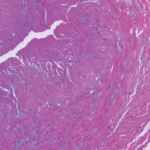Unlike aortic dissection, which is often fatal without treatment, dissection of the SMA doesn’t have the same prognosis, possibly because there is less pressure throughout the vessel; however, this can lead to narrowing and thrombosis in the lumen of the vessel. Given the rarity, no standard therapy exists. For an acute abdomen, open surgery is needed.
Genetic testing is the gold standard for diagnosing vascular EDS.
If the patient is asymptomatic or symptomatic without evidence of bowel ischemia, SMA dissection may be treated with bowel rest and heparin, a course of treatment proposed by Ambo et al.6 Anticoagulants prevent clot and emboli formation, which help recanalize the true lumen. Antiplatelet therapy is also used to prevent arterial thrombosis. No data exist to indicate the optimal dosage or administration period. Although some say medical treatment should continue until radiographic evidence of resolution of the dissection, others suggest anticoagulation with vitamin K antagonists for one year.7,8 Unfortunately, as seen in this case, when complications, such as catastrophic vessel rupture occur, heparin administration may complicate this further.
Conclusion
It is important to think of rare collagen vascular diseases, such as vascular EDS, and non-inflammatory vessel disorders, such as SAM, when evaluating patients for a possible diagnosis of PAN. Clues to look for include external signs and family history, and you should obtain genetic testing in a timely manner. However, the window of opportunity is often small in patients with catastrophic presentation, and one may feel obligated to treat such a patient, cautiously, for a possible diagnosis of medium-vessel vasculitis, which would progress in the absence of immunosuppression. Biopsy is often not possible, and angiograms may lead to further complications. Unfortunately, this diagnosis is often established after postmortem examination.
 Catherine (Katie) Donnelly, MB, BCh, BAO, is a second-year rheumatology fellow at the University of Cincinnati Medical Center.
Catherine (Katie) Donnelly, MB, BCh, BAO, is a second-year rheumatology fellow at the University of Cincinnati Medical Center.
 Surabhi Khanna, MD, is an assistant professor of rheumatology and heads the Scleroderma Center at the University of Cincinnati Medical Center.
Surabhi Khanna, MD, is an assistant professor of rheumatology and heads the Scleroderma Center at the University of Cincinnati Medical Center.
References
- Beighton P, De Paepe A, Steinmann B, et al. Ehlers-Danlos syndromes: Revised nosology, Villefranche, 1997. Ehlers-Danlos National Foundation (USA) and Ehlers-Danlos Support Group (UK). Am J Med Genet. 1998 Apr 28;77(1):31–37.
- Malfait F, Francomano C, Byers P, et al. The 2017 international classification of the Ehlers-Danlos syndromes. Am J Med Genet C Semin Med Genet. 2017 Mar;175(1):8–26.
- Pepin M, Schwarze U, Superti-Furga A, Byers PH. Clinical and genetic features of Ehlers-Danlos syndrome type IV, the vascular type. N Engl J Med. 2000 Mar 9;342(10):673–680.
- Kato T, Hattori H, Yorifuji T, et al. Intracranial aneurysms in Ehlers-Danlos syndrome type IV in early childhood. Pediatr Neurol. 2001 Oct;25(4):336–339.
- Baker-LePain JC, Stone DH, Mattis AN, et al. Clinical diagnosis of segmental arterial mediolysis: Differentiation from vasculitis and other mimics. Arthritis Care Res (Hoboken). 2010 Nov;62(11):1655–1660.
- Ambo T, Noguchi Y, Iwasaki H, et al. An isolated dissecting aneurysm of the superior mesenteric artery: report of a case. Surg Today. 1994;24(10):933–936.
- Nagai T, Torishima R, Uchida A, et al. Spontaneous dissection of the superior mesenteric artery in four cases treated with anticoagulation therapy. Intern Med. 2004 Jun;43(6):473–478.
- Takach TJ, Madjarov JM, Holleman JH, et al. Spontaneous splanchnic dissection: Application and timing of therapeutic options. J Vasc Surg. 2009 Sep;50(3):557–563.
